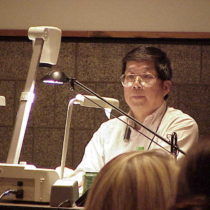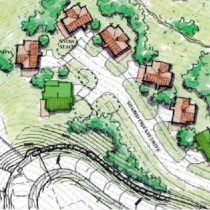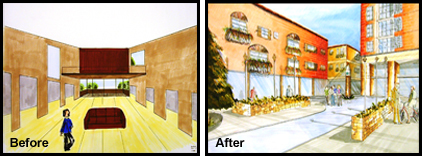Landscape Architecture for Landscape Architects › Forums › GRAPHICS › Why landscape designers can’t draw with hand comfortably anymore?
- This topic has 1 reply, 6 voices, and was last updated 14 years, 2 months ago by
 nca.
nca.
-
AuthorPosts
-
September 25, 2011 at 4:19 pm #160334
 Mike LinParticipant
Mike LinParticipantImprovement of Before / After drawings in just
one week during the BeLoose Graphic WorkshopFor the past 35 years, I have taught at universities and run the BeLoose Graphic Workshop on “how to draw quickly and convincingly with hand”. I have found the following reasons that most landscape designers are afraid of using hand graphics on their daily projects. I also listed their solutions to share with you.
1. Lack of talent or believe having no art in their blood.
To be talented in drawing, one only needs to work hard, learn tricks and copy others’ drawings.2. Afraid of making mistakes when draw.
Mistakes lead to improvement after good and honest criticism.3. Don’t like to be criticized or laughed at their drawings.
Proper guidance will allow you not to make the same mistake twice.4. Worry about bad drawings that can affect academic GPA or office promotion.
Most successful designers received C average in school, besides employers don’t look at GPA Or if you are good in the firm, why worry getting canned.5. Like to compare with their peers and feel pressure.
When you are good, people get jealous on you. so often need to be humble to be liked.6. Expect to draw perfect but their hand can’t deliver the product.
You need to know how to draw well so your eye will agree with your hand which delivered. Remember a designer doesn’t need to draw well, it is only the process unlike the artist which a drawing is a product.7. No confidence when draw, often got discouraged.
Because you failed often, by drawing well will boost your confidence in drawing.8. Too tight or anal, just can’t be loose.
Too tight or anal means you have bad graphic skills with bad attitude. Being loose means having good graphics.9. Rely on computer so hand graphic skill doesn’t get chance to improve.
Rely on computer which uses left brain, to be a good designer, use hand graphics can only make you to use more right brain and be more creative.10. Lack of graphic skills or not been taught well in school.
Take a reputable graphic workshop that will improve your graphic skills instantly.I welcome your opinion and looking forward to hearing from you.
September 25, 2011 at 5:22 pm #160347 ncaParticipant
ncaParticipantMike,
I bought a copy of your book in 2003 or 2004 and followed each exercise and copied the styles in the book on landscape plans I worked on before I went back to school for landscape architecture in 2005. Your book helped me a lot and in some ways led me to becoming a landscape architect. So, thank you.
I agree on the importance of hand drawing, but I also think some of your methods can be applied to digital drawing. In many instances, right brain thought can happen during computer drawing as well, especially when you incorporate a graphics tablet. Sure, there is still some undeniable disconnect between the hand and paper when working on the computer and I see the value in that, but I think it is possible to exercise creativity on the computer.
I feel lucky to have discovered your book so early on in my career. I think in either medium though, digital or hand, we as designers need to be careful not to get too caught up in stylization of our graphics. I think a lot of designers get stuck on drawing in one style or another and forget about the end goal–the quality of the design itself. Personally, I think many designers could benefit from good fundamental black and white drawing techniques over which colors to use, etc., though I think both are important.
I see alot of built work that I think suffers almost solely because it was designed on the computer. I’ve noticed a lot of parks and other spaces that look like computer models in their built form, which I think is unfortunate.
What do you think?
September 25, 2011 at 7:35 pm #160346 Heather SmithParticipant
Heather SmithParticipantI feel like I was taught great hand graphics from Stephen Drown at the University of Idaho. I am really grateful for the knowledge he shared with us.
September 26, 2011 at 12:13 am #160345 Mike LinParticipant
Mike LinParticipantI know Stephen and he is a very good graphic teacher, lucky you and please say hi to him for me.
September 26, 2011 at 12:14 am #160344 Mike LinParticipantSeptember 26, 2011 at 12:18 am #160343
Mike LinParticipantSeptember 26, 2011 at 12:18 am #160343 Mike LinParticipant
Mike LinParticipantNot only most universities will not do what you suggested, some are now even offering only 5 years to receive MLA instead of BLA. With the lack of hand graphics in these programs, are we in the wrong direction in our profession?
September 26, 2011 at 2:56 am #160342 Jason T. RadiceParticipant
Jason T. RadiceParticipantThere is a general lack in teaching design…period. Students are taught to make the presentaions look nice on the computer, and so much time is spent teaching the tools that little time or attention is paid to the quality of the design the student actually produces. No attention to the details, function, forms, or even overall plausibilty. Much more emphasis as been placed on ecology and environment, and yet, the requirements for actually studying the pure science of it has also diminished. There is so much to learn in so little time, and not enough specialization options for the students.
September 26, 2011 at 3:59 am #160341 earthworkerParticipant
earthworkerParticipantIn the real world, in a real office, drawing is becoming less critical for many reasons. For one, illustrative graphics and perspective sketches are not required for most bread and butter landscape architecture projects. Most projects don’t have a budget for this type of work and clients don’t want to pay for it. They simply want enough work to get their project pushed through the approval process and the design firms want to get the project done and get paid as quickly as possible.
Hand drawings are also unique to each individual. If an illustrative, hand-drawn perspective needs to be changed, it will typically be changed by the original production person. In a fast paced, design firm, the original designer may be too busy to make modifications to the original drawing. That is why many offices will have only one maybe two ‘graphics’ guys they use to keep their illustrations consistent.
The informed clients who do want illustrative graphics want more than just a few hand sketches these days. They want fly-throughs, aerial perspectives and the ability to change things instantly. They want shadow studies and the ability to compare materials in relation to one another. Some municipalities and government agencies require environmental graphics that are accurate to within a few feet and include alternative designs.
Yes, it would be nice to draw lots of perspectives and illustrate plan views all day long. Unfortunately, the real world is way beyond that. It’s good to know the basics of hand-drawn graphic composition but by no means is the profession based on that alone anymore. After nearly 11 years in the profession, I have learned that drawing is only a tiny portion of what makes a good landscape architect.
September 26, 2011 at 11:38 pm #160340 Mike LinParticipant
Mike LinParticipantI couldn’t agree more Jason, I believe most people find hard to learn “how to draw” with hand and this may be one of the main reasons why people shy away from hand graphic and go toward computer more. Our BeLoose graphic workshop has proven that if one can breathe, we can teach them how to draw quickly and convincingly.
September 26, 2011 at 11:38 pm #160339 Mike LinParticipant
Mike LinParticipantThanks Henry.
September 26, 2011 at 11:50 pm #160338 Mike LinParticipant
Mike LinParticipantYes, I see you point loud and clear, thanks. But I only want to emphasize that a designer should use hand graphic to apply it during the design process and should use it more often to communicate with his creative side of right brain and his clients.
I believe it is more spontaneous and not to mention that it is also more quickly and efficiently. I have been invited to many well known firms and best designers out there are still using hand graphics more. Sad to see more entry level designers are more CAD driven and start losing the Hand Graphics capability. Time will tell if we are going to the right direction or not.
September 27, 2011 at 2:10 am #160337 Steve MercerParticipant
Steve MercerParticipantHi Mike,
I am one of those fellas that yearns for just a thimbal’s worth of artistic ability. I certainly agree with you that a designer that can draw effectivly and can communicate those designs well to the client can breeze quickly through the conceptual stage. And I think we would all be better designers if more attention was paid to these skills especially at concept. I think it really depends on the type of work you are doing. The small projects i.e. residental and the really large projects both have the most potential for hand graphics. I see a hybrid emerging though. One in which Construction drawings are done in CAD and 3D perspectives are created in SketchUP from the CAD Drawings and then either Augmented with hand graphics or the fly thru computer renderings are created. I think this gives the designer the most flexibility. It depends on the size AND the scope of the project and most importantly who the audience will be for the end product. That is why I chose LandFX. I can create all my construction drawings in CAD and then export the drawing into SketchUP where a 3D Model can quickly be built. LandFX swaps all the 2D CAD/or 3D SketchUp symbols bi-directionally in their SketchUP plug-in. At the point where the 3D computer model is complete, If a hand rendered drawing is desired, a perspective can be chosen in the model and output to paper where the hand rendering can begin. Or if a computer rendering is desired the SketchUp model can be exported into a rendering engine such as VUE for a more realistic walk/fly thru of the model. The beauty of using LandFX is that it sets on top of AutoCAD and they have a Plug-in now for Revit so your investment in learning their technology is following longterm industry trends on the software development side. At some point I want to get with you and learn more about the hand graphics but for now I have my hands full just getting my brain crammed full of all the technical junk (including how to survey with a Robotic Total Station)
s.
September 28, 2011 at 4:44 am #160336 Mike LinParticipant
Mike LinParticipantHi Steve, thanks for your opinion, well said. Hope to see you in one of our graphic workshops.
September 28, 2011 at 10:20 am #160335 Mike LinParticipant
Mike LinParticipantIndeed, I am a true believer on having quick ideas with hands that can put down on paper instantly, this way our right brain (the creative side) will engage more. As long as I can breathe, I will continue to push the hand graphics to where ever I can reach.
-
AuthorPosts
- You must be logged in to reply to this topic.




Hi Nick,
I agree with your opinion totally. I never intend to talk down the computer, but many schools shouldn’t take away graphic classes that build a very basic and important foundation for becoming a good designer. I begin to see that knowing hand graphics is now called a “Niche”, it is like take an expensive fight on a business class, so many designers rather take the coach class to save money, so they didn’t have a chance to enjoy their flight.